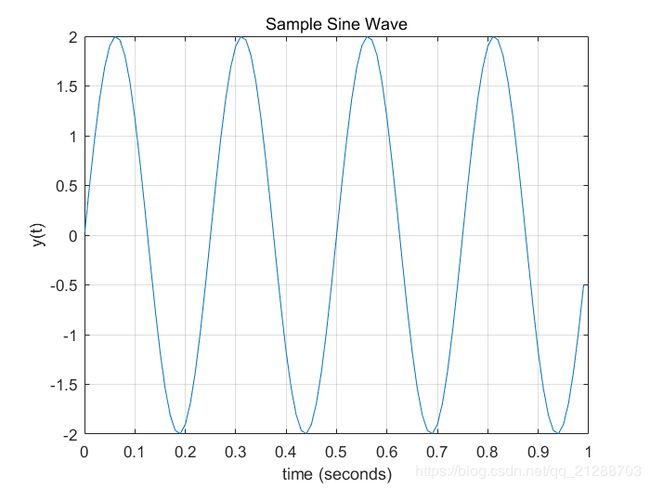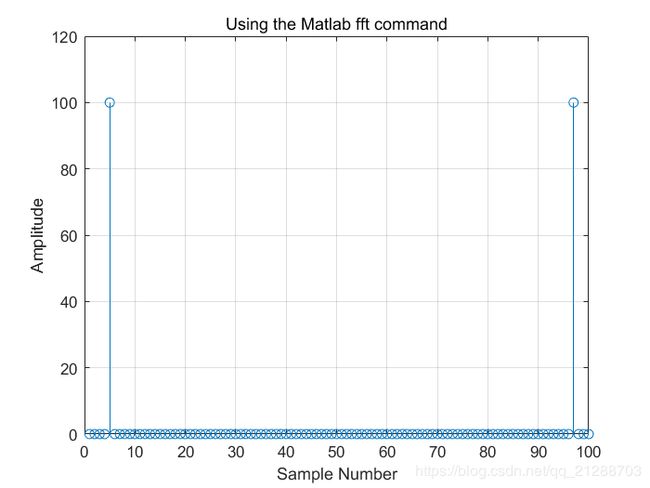使用matlab进行频域分析
信号的频谱 频谱密度 功率谱密度 能量谱密度的区别
(详见参考2)
信号按能量是否有限分为:
- 能量信号:能量有限,平均功率为0。如单位冲击信号。
- 功率信号:能量无限,功率非0。如节约信号,或某个电压非ode直流或周期信号。
信号的频率特性共有以下四种
- 功率信号的频谱
- 能量信号的频谱密度
设一个能量信号s(t),则它的傅里叶变换定义为频谱密度函数。 - 能量信号的能量谱密度
- 功率信号的功率谱(密度)
如何使用matlab进行频域分析
fo = 4; %frequency of the sine wave
Fs = 100; %sampling rate
Ts = 1/Fs; %sampling time interval
t = 0:Ts:1-Ts; %sampling period
n = length(t); %number of samples
y = 2*sin(2*pi*fo*t); %the sine curve
%plot the cosine curve in the time domain
sinePlot = figure;
plot(t,y)
xlabel('time (seconds)')
ylabel('y(t)')
title('Sample Sine Wave')
grid
- 信号的频谱定义为信号在各个频率上的分布大小,对于一个能量有限的信号,它的频谱密度函数为它的傅里叶变换的结果。
其中傅里叶变换提供了一个将信号从时域转变到频域的方法。 - 下图为fft之后,又abs的结果,因为傅里叶变换结果是个complex。存在以下问题:x轴不能提供频率信息;幅度都是100;没有让频谱中心为0.
%plot the frequency spectrum using the MATLAB fft command
matlabFFT = figure; %create a new figure
YfreqDomain = fft(y); %take the fft of our sin wave, y(t)
stem(abs(YfreqDomain)); %use abs command to get the magnitude
%similary, we would use angle command to get the phase plot!
%we'll discuss phase in another post though!
xlabel('Sample Number')
ylabel('Amplitude')
title('Using the Matlab fft command')
grid
axis([0,100,0,120])
为FFT定义一个函数来获取双边频谱
以下代码可以简化获取双边频谱的过程,复制并保存到你的.m文件中
function [X,freq]=centeredFFT(x,Fs)
%this is a custom function that helps in plotting the two-sided spectrum
%x is the signal that is to be transformed
%Fs is the sampling rate
N=length(x);
%this part of the code generates that frequency axis
if mod(N,2)==0
k=-N/2:N/2-1; % N even
else
k=-(N-1)/2:(N-1)/2; % N odd
end
T=N/Fs;
freq=k/T; %the frequency axis
%takes the fft of the signal, and adjusts the amplitude accordingly
X=fft(x)/N; % normalize the data
X=fftshift(X); %shifts the fft data so that it is centered
这个函数输出正确的频域范围和变换后的信号,它需要输入需要变换的信号和采样率。
接下来使用前文的正弦信号做一个简单的示例,注意你的示例.m文件要和centeredFFT.m文件在一个目录下
[YfreqDomain,frequencyRange] = centeredFFT(y,Fs);
centeredFFT = figure;
%remember to take the abs of YfreqDomain to get the magnitude!
stem(frequencyRange,abs(YfreqDomain));
xlabel('Freq (Hz)')
ylabel('Amplitude')
title('Using the centeredFFT function')
grid
axis([-6,6,0,1.5])
为FFT定义一个函数来获取右边频谱
从上图可以看出,FFT变换得到的频谱是左右对称的,因此,我们只需要其中一边就能获得信号的所有信息,我们一般保留正频率一侧。
以下的函数对上面的自定义函数做了一些修改,让它可以帮助我们只画出信号的正频率一侧
function [X,freq]=positiveFFT(x,Fs)
N=length(x); %get the number of points
k=0:N-1; %create a vector from 0 to N-1
T=N/Fs; %get the frequency interval
freq=k/T; %create the frequency range
X=fft(x)/N; % normalize the data
%only want the first half of the FFT, since it is redundant
cutOff = ceil(N/2);
%take only the first half of the spectrum
X = X(1:cutOff);
freq = freq(1:cutOff);
和前面一样,使用正弦信号做一个示例,下面是示例代码
[YfreqDomain,frequencyRange] = positiveFFT(y,Fs);
positiveFFT = figure;
stem(frequencyRange,abs(YfreqDomain));
set(positiveFFT,'Position',[500,500,500,300])
xlabel('Freq (Hz)')
ylabel('Amplitude')
title('Using the positiveFFT function')
grid
axis([0,20,0,1.5])
参考资料
- https://blog.csdn.net/juhou/article/details/82024846
- https://blog.csdn.net/zhanghaijun2013/article/details/95060499?utm_medium=distribute.pc_relevant.none-task-blog-BlogCommendFromMachineLearnPai2-1.nonecase&depth_1-utm_source=distribute.pc_relevant.none-task-blog-BlogCommendFromMachineLearnPai2-1.nonecase


